Quentin Tarantino’s first 25 Years, Part 2 – Pulp Fiction (1994).
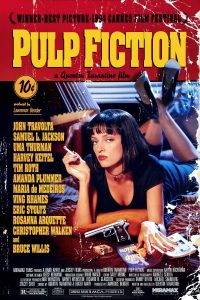 Occasionally I’m required, and sometimes just compelled, to write about movies that are so iconic and so engrained in popular culture that it’s difficult to know how best to approach them. They’ve already been the subject of innumerable articles offering probing analysis of various aspects such as their inception and production to their eventual success and influence on the landscape of film. As part of this series, my previous article was a retrospective of Quentin Tarantino’s first feature film, Reservoir Dogs, a film rightly regarded as one of the greatest of all directorial debuts. Many a director whose breakout film has been a huge success has failed at the second hurdle, that difficult second album factor. Just look at Richard Kelly for example. His 2001 debut, Donnie Darko was a fairly big commercial success making back many times it’s meagre $4.5 million budget. Critically it was a huge success and whilst still seen by many as a cult film it’s easy to forget how big a deal it was at the time. Not an explosive success but certainly one that snowballed into something far bigger than anyone could have reasonably expected. Sadly Kelly was not able to follow up on the promise he showed in Donnie Darko and the claims by many that he was Hollywood’s next big thing never came to pass. Another example, going further back is Michael Cimino whose 1978 film The Deer Hunter bagged 5 Oscars including Best Picture and Best Director and is regarded by many as one of the greatest films ever made. Again it was a success that Cimino was not able to follow up on given how spectacular a flop his follow up film, 1980’s Heaven’s Gate was both critically and especially from a commercial point of view.
Occasionally I’m required, and sometimes just compelled, to write about movies that are so iconic and so engrained in popular culture that it’s difficult to know how best to approach them. They’ve already been the subject of innumerable articles offering probing analysis of various aspects such as their inception and production to their eventual success and influence on the landscape of film. As part of this series, my previous article was a retrospective of Quentin Tarantino’s first feature film, Reservoir Dogs, a film rightly regarded as one of the greatest of all directorial debuts. Many a director whose breakout film has been a huge success has failed at the second hurdle, that difficult second album factor. Just look at Richard Kelly for example. His 2001 debut, Donnie Darko was a fairly big commercial success making back many times it’s meagre $4.5 million budget. Critically it was a huge success and whilst still seen by many as a cult film it’s easy to forget how big a deal it was at the time. Not an explosive success but certainly one that snowballed into something far bigger than anyone could have reasonably expected. Sadly Kelly was not able to follow up on the promise he showed in Donnie Darko and the claims by many that he was Hollywood’s next big thing never came to pass. Another example, going further back is Michael Cimino whose 1978 film The Deer Hunter bagged 5 Oscars including Best Picture and Best Director and is regarded by many as one of the greatest films ever made. Again it was a success that Cimino was not able to follow up on given how spectacular a flop his follow up film, 1980’s Heaven’s Gate was both critically and especially from a commercial point of view.
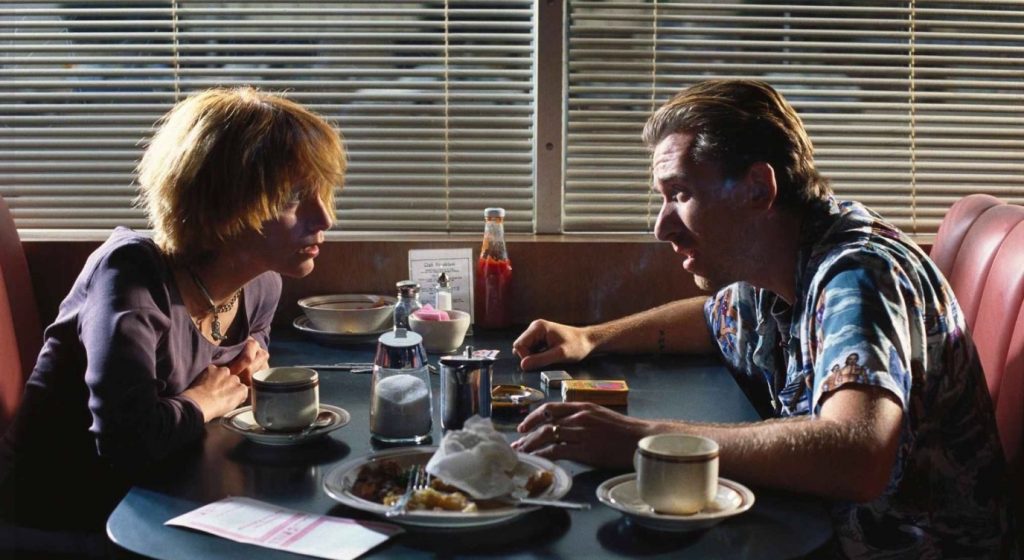
Now, Quentin Tarantino does not fit into this category of one hit wonder directors. His first film was as good a debut as any director could ever hope for and if you read that earlier article you’ll know how highly I regard it. The pressure was certainly on Hollywood’s new wunderkind to deliver a worthy follow-up and that film was 1994’s Pulp Fiction. So we circle back to my opening question, do I lay the groundwork of analysis and build to a conclusion as is the expected norm with such retrospective analysis? Well, with Pulp Fiction I’d argue that there’s not much point, you already know the punchline. If Reservoir Dogs was one of the all time greatest debuts then I’d just as easily declare that Pulp Fiction is one of the greatest if not THE greatest sophomore efforts from any director and one of those rare films that I’d happily give a perfect 10/10 score. So there’s the conclusion that would come at the end of a regular article but we’re not dealing with a regular kind of movie here are we.
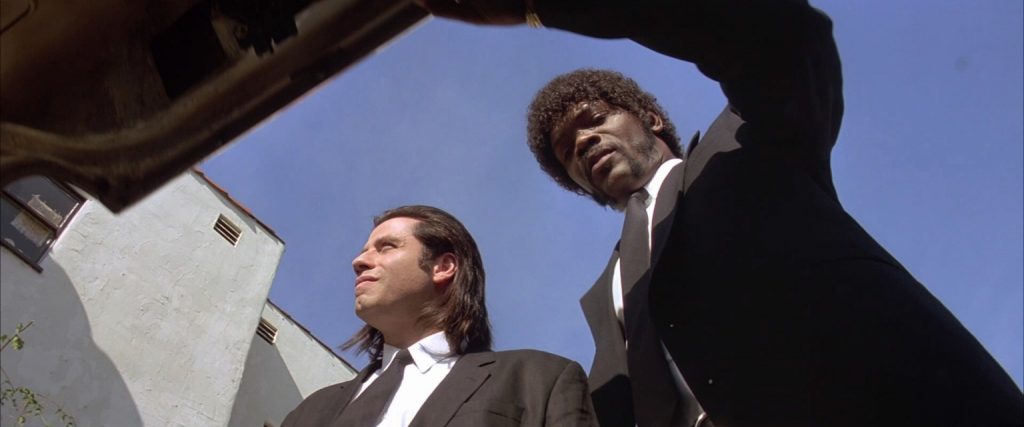
Much as he did with Reservoir Dogs, Tarantino once again employs a non-linear storytelling technique in Pulp Fiction. More than being just a flashy gimmick, by chopping up the narrative Tarantino skilfully segments the film into three distinct stories but which all form part of a cohesive whole, another tale of L.A. criminality. Whereas Reservoir Dogs was the epitome of indie filmmaking on a tight budget, Pulp Fiction, whilst certainly still not a big budget film was nevertheless gifted a far bigger budget than its predecessor, at around $8 million as opposed to Dogs’ $1.2 million. That extra financial cushion was put to great use by Tarantino. From a purely visual point of view Tarantino’s second film has a lush and vibrant aesthetic that Dogs lacked. Whilst the heightened colour palette here may intentionally reflect the slightly more stylised approach the director took, it certainly imbues Pulp Fiction with a look that’s far more eye catching than the grimier looking Dogs. Clearly the bigger budget allowed for far better lighting and post production even though Pulp Fiction was filmed with similar cameras and film stock to Dogs. It’s a sumptuous looking film and great care seems to have been taken with the lighting and composition of every frame.
Tarantino’s song choices here may well represent the most meticulously considered and flawlessly matched musical pairings of any film. From the opening credits to the Jack Rabbit Slim’s dance contest and beyond, the songs used from the likes of Kool & The Gang, Al Green, Dusty Springfield, Ricky Nelson and Chuck Berry to name but a few, perfectly fit the vibe and feel of their respective scenes and are now synonymous with the film.
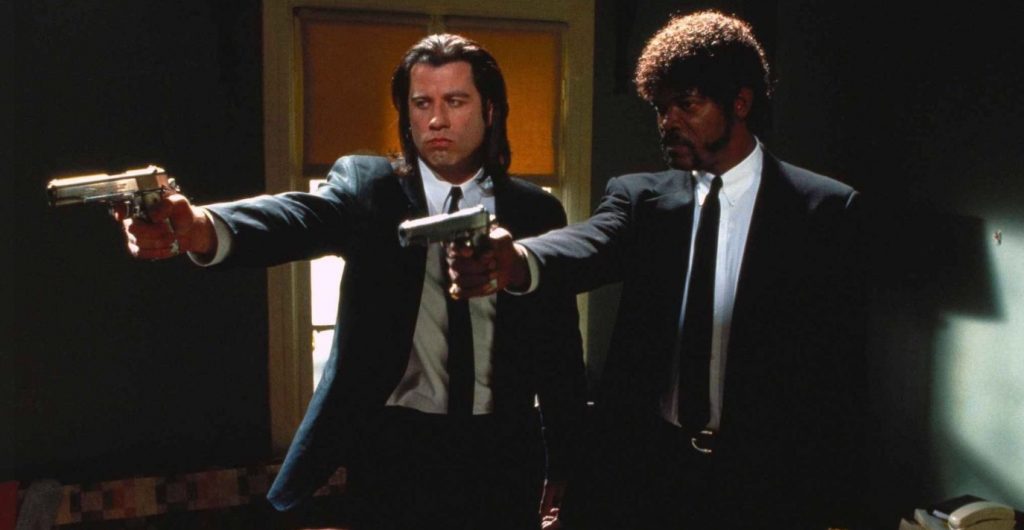
Whilst Dogs was shot in 35 days and on a tight budget this time around Tarantino had few constraints and is in complete control of every element of the film. Every single facet of Pulp Fiction, no matter how small seems to have been crafted with an almost surgical precision. This is apparent from the off with the striking title font replete with little audio flourishes such as the static as the radio station is changed to denote the segue into a different track as the opening titles are playing. Later on Tarantino’s purposeful use of shoddy rear projection during Butch’s post-fight cab ride subtly heightens the cartoonish surrealism of the scene. These little creative and artistic flourishes are used frequently and to magnificent cumulative effect throughout. The film has an effortless cool and each and every scene has either a memorable image or line of dialogue that contributed to it rapidly achieving a level of pop culture iconography that few other films could ever hope to achieve.
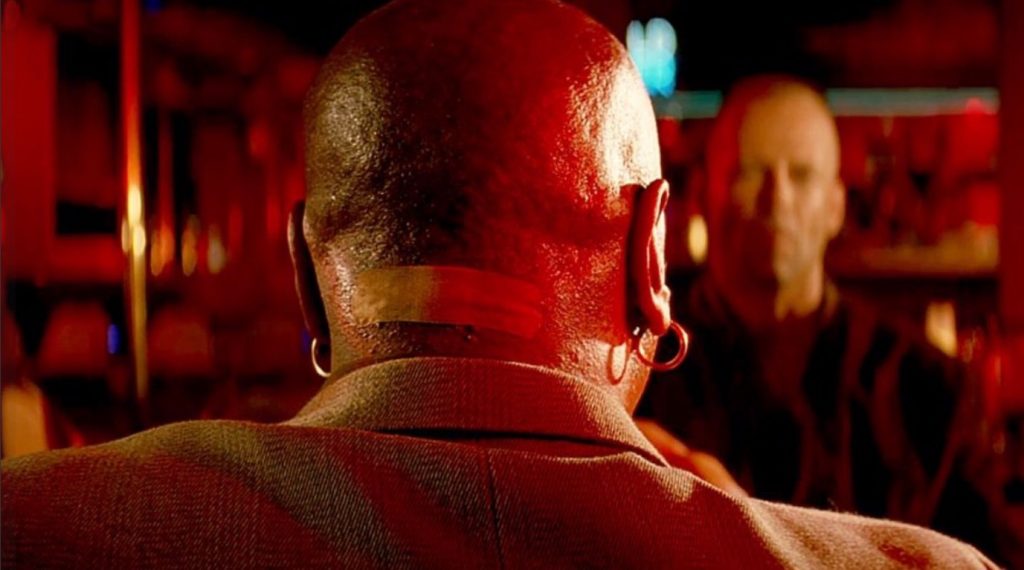
The casting is the stuff of dreams. Returning from Dogs are Harvey Keitel, Tim Roth and Tarantino himself and whilst they weren’t cast in principle roles they’re none the less memorable. Pulp Fiction has a wide and stellar ensemble cast and made Samuel L. Jackson a star overnight. His casting as hitman Jules Winnfield is one of many inspired casting choices. Jackson delivers much of the best and most memorable lines and that’s really saying something when you have a script as flawless as Pulp Fiction’s. It could be said that Jackson’s character is the beating heart of the film as ultimately it concludes with the redemption of Jules who, having deciphered what he believes to be a divine message, is now ready to give up his life of crime and murder before his luck runs out. All the principle cast go through some form of cathartic development but Jules’ is the most profound and even though Samuel L. Jackson’s career blossomed and hasn’t really abated he really has never topped his Oscar nominated performance in Pulp Fiction.
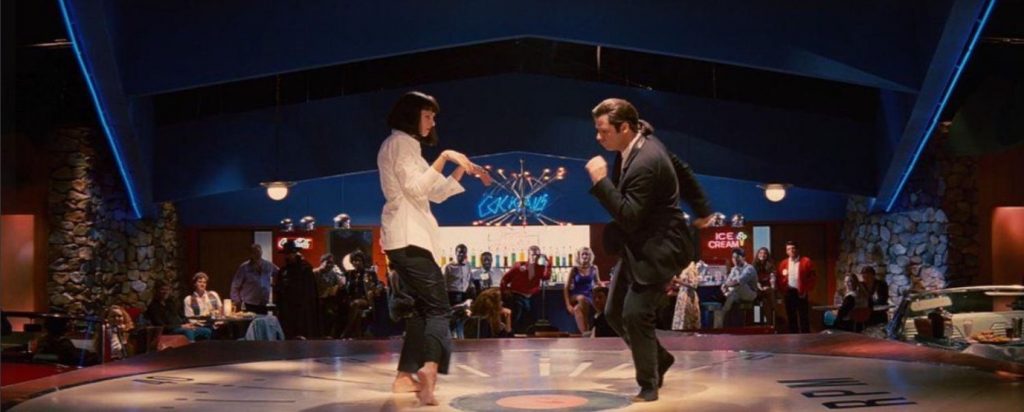
Prior to the film’s release in 1994 the career of John Travolta had taken something of a downturn. As much as he was still making money from voicing roles such as in the Look Who’s Talking films, his meatier acting roles had dried up and he wasn’t the household name he was back in the late ’70s following the success of hits such as Saturday Night Fever and Grease. In casting Travolta as Jules’ hitman partner Vincent Vega, Tarantino gave the actor a much needed career jumpstart and Pulp Fiction remains arguably his best role. Travolta, like most of the cast, exudes a distinct sense of cool from every pore and in one of the film’s most famous scenes we actually get to see Travolta strut his stuff on the dance floor once more. It’s playing to both Travolta’s strengths and also a clever manipulation of audience nostalgia and provides us with a small moment of cinematic joy that will play even better to those familiar with the actor’s past work.
Uma Thurman as the wife of gangster Marsellus Wallace commands the screen with a sexiness, style and feline swagger that enraptured an entire generation and that now famous image of Thurman lying on the bed, cigarette, gun and pulp novel to hand is certainly one of the most effective and iconic movie posters ever. Bruce Willis, Ving Rhames, Eric Stoltz, Rosanna Arquette, Tim Roth, Amanda Plummer and Christopher Walken round out the majority of the stellar ensemble cast.
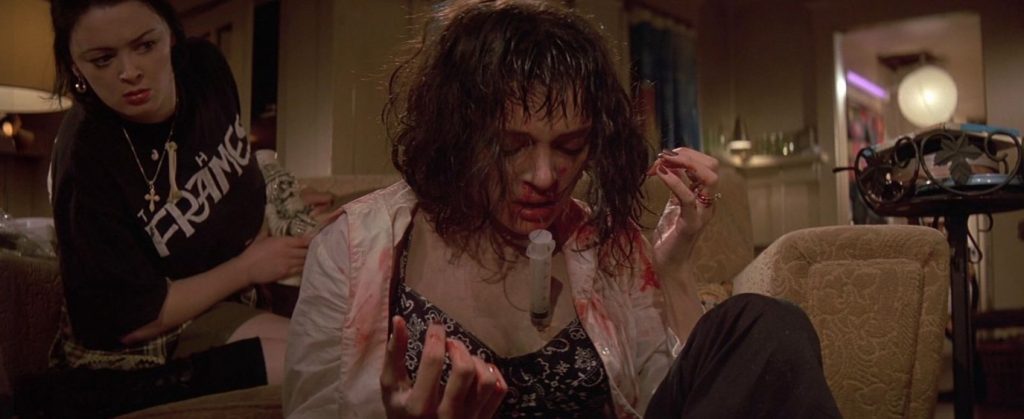
As with Reservoir Dogs, Pulp Fiction doesn’t hold back in its depiction of graphic violence although by today’s standards it’s hardly anything that will cause the same level of outcry that it did back in the mid 1990s. The tension leading up to these moments of violence is ratcheted up further by the use of Tarantino’s ever engaging, extended dialogue scenes to delay the inevitable. An example of this is when Jules and Vincent arrive at an apartment to do a “job” but arrive early. Being the consummate professionals they are, instead of carrying out their grisly assignment ahead of schedule, they move away from the apartment and continue their earlier conversation. This delaying of the inevitable continues inside, most famously and effectively when Jules delivers his iconic Ezekiel 25:17 sermon, itself a bastardisation of the actual biblical text.
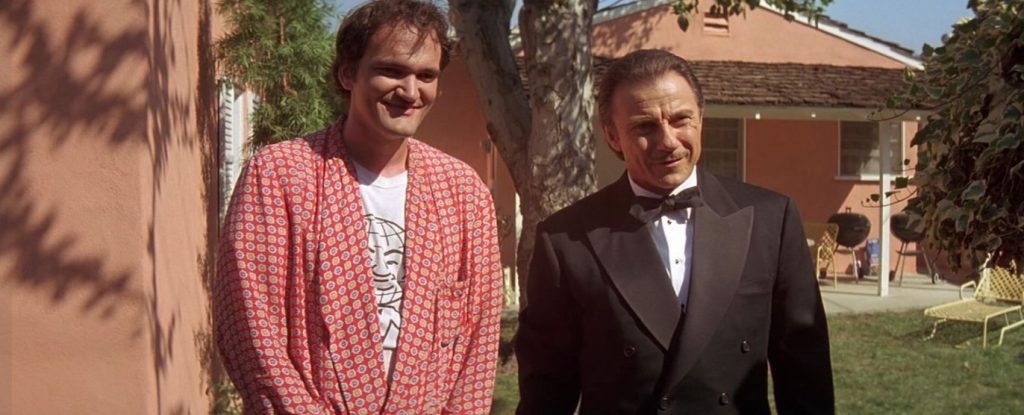
I could just as easily pad this article out by listing Pulp Fiction’s innumerable iconic scenes but that would serve no purpose as those who have seen the film will likely not require such a reminder of these scenes and those who haven’t seen the film should stop reading this immediately and rectify that matter with haste. When rewatching Pulp Fiction recently in preparation for this retrospective I was struck by a recurring thought that’s surfaced several times over the years regarding the film’s script. That thought relates to how Tarantino ever conceived of the chopped up, non-linear narrative. How he pieced together this irregular, non conformist puzzle that somehow fits together perfectly even though events unfold in an order totally at odds with any standard chronology, yet works so perfectly is completely beyond me and leaves me to conclude that the man was touched by a stroke of genius. It really is one of the most perfectly structured films and the 154 minute runtime just flies by.
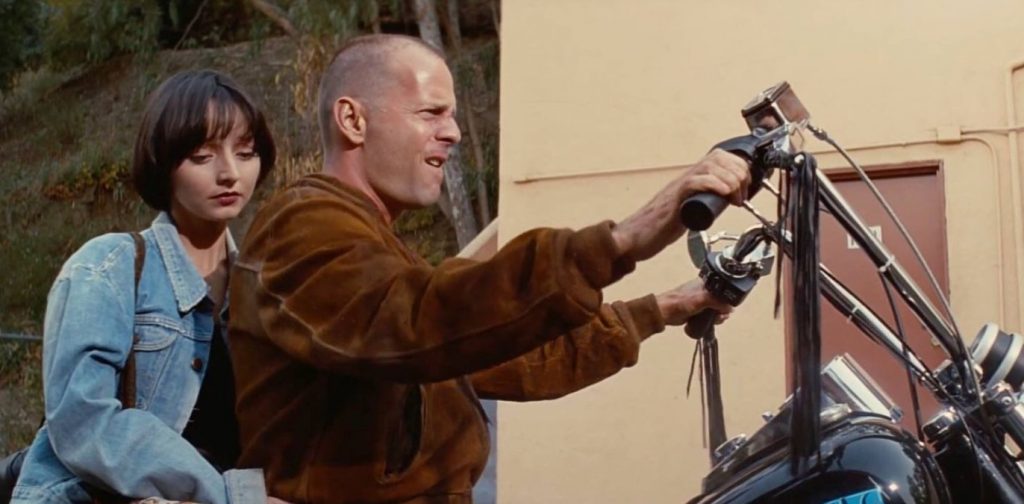
Part of what makes Pulp Fiction so eminently rewatchable is the deeply layered plot and narrative. There’s so much to dissect and contemplate and discuss with friends; What’s in Marsellus’ briefcase? Why did he throw Antoine off the balcony? Who keyed Vincent’s car (follow the chronology carefully and it would point towards Butch) and what the heck is the Gimp’s story? Does he actually live in that box? None of these questions need answers but asking them and coming to your own conclusions is half the fun of going back to the film every so often, each viewing uncovers new treasures to consider.
With Reservoir Dogs, Tarantino breathed life into the indie film movement. With his second film he made the first indie film to break the $100 million barrier and a film that became so utterly iconic and beloved that it earned every single accolade thrown at it. Pulp Fiction sits at No.7 on the IMDB Top 250 films of all time and rightly so. In a recent poll I conducted on Twitter it came out on top of the 9 films Tarantino has directed in his now 25 year career but more than merely being arguably his best film it’s undoubtedly one of the best films of the ’90s and one of the most iconic and important films of that or any decade.
Film ’89 Verdict – 10/10

